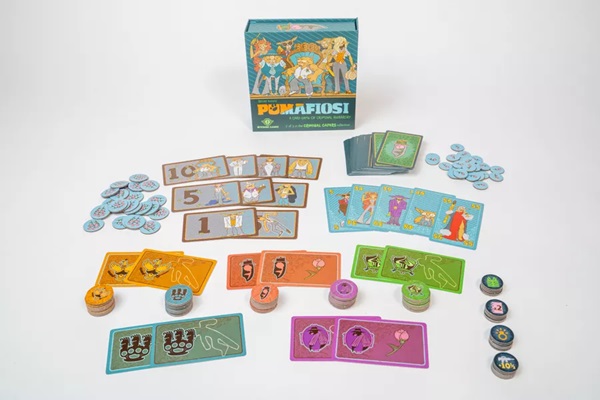Pumafiosi: A Strategic Balancing Act of Trick-Taking and Hierarchy

In the world of the puma mafia, it’s hard to come out on top. Too much attention and you’re a target, but if you never make a big play you’ll sink fast.
Published by Bitewing Games and designed by Reiner Knizia, Pumafiosi is a trick-taking card game designed for 2-5 players, with a 20-minute playtime.
Gameplay
Each player is dealt three cards for their hand and seven cards for their personal draw piles. Cards can range in value from 1-55. The 10 hierarchy cards are placed on the table in a column from highest to lowest – these are numbered 10 to -3.
At the start of each trick, the person leading plays one of his cards face-up on the table, and then everyone else takes turns playing one card into the trick. As soon as someone has played a card, he draws a new card into his hand. The person who played the second-highest card is the winner of the trick and will lead the next one.
After a player wins a trick, he puts his card next to one of the hierarchy cards, placing one of his player tokens on top of it. He may place it next to a hierarchy card that does not currently have a card next to it, or next to one where there is a card of a lower value, bumping that card down the hierarchy column to the next card. This can cause a chain reaction if there is another card already one spot below it. Whenever there are two cards in a slot of the hierarchy column, the card with the lower value is bumped another space down. The only time this does not happen is for the lowest spot on the hierarchy column, the -3 spot. Multiple cards can be in that space. Any time a player’s card is knocked down a slot on the hierarchy column, he earns one penalty point.
After 10 tricks, the round ends. For each card a player has on a hierarchy spot, he earns points equal to the value of that spot. If a player has no points on the hierarchy column, he earns 10 penalty points. A player’s score at the end of the round consists of the total of all points minus penalty points. The cards are then reset, and a new round is played. The player with the most points after three rounds wins the game.

Review
Pumafiosi is a unique trick-taker with intriguing player interaction and choices. The fact that you choose your placement in the hierarchy when you win a trick adds a lot of strategy to the gameplay. Players are motivated not to go straight to the number 10 card, balancing their card’s value with the value of each hierarchy position and trying to choose a location where they’ll get bumped the least.
At the same time, you might be looking at which players you should be actively trying to bump, while also trying to avoid creating chain reactions that will bump your own cards. Sometimes, it’s better not to win a trick if winning means you’ll get a low-numbered card on the hierarchy column — the lower your card, the more likely it will get knocked down the hierarchy and incur penalty points.
Since what cards are in play varies from round to round based on what is dealt, players don’t necessarily know immediately what the high and low cards are until more cards start coming out, so there’s a lot of feeling things out, and maybe holding back certain cards as players try to work out their placement.
There’s a lot of strategy going on here without it being complicated to learn. There are some optional item rules that are a bit more of a chore to understand, but since items are an optional variant, you can wait to tackle them until you’ve already got the hang of the core gameplay. The rulebook does get a bit confusing in what it calls rounds vs. games, but it’s not too hard to figure out what it means.
We really enjoyed Pumafiosi. It’s strategic and feels like a unique trick-taker. It can be a bit confrontational when you send someone down the hierarchy chain, but in general we loved the player interaction and all the elements it added to the gameplay.
Pros: Tons of player interaction, interesting choices between trick-taking and scoring mechanics
Cons: Rulebook’s use of ‘rounds’ vs ‘games’ is a little confusing, items variant felt like an unnecessary complication
Disclosure: we received a complimentary review copy of this game.







